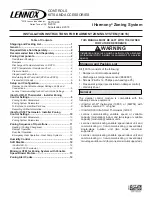
En-8
4.3. Flare connection (Pipe connection)
WARNING
Tighten the flare nuts with a torque wrench using the specified tightening method.
Otherwise, the fl are nuts could break after a prolonged period, causing refrigerant to
leak and generate a hazardous gas if the refrigerant comes into contact with a fl ame.
4.3.1. Flaring
• Use special pipe cutter and fl are tool exclusive for R410A.
(1)
Cut the connection pipe to the necessary length with a pipe cutter.
(2)
Hold the pipe downward so that cuttings will not enter the pipe and remove any
burrs.
(3)
Insert the fl are nut (always use the fl are nut attached to the indoor and outdoor units
respectively) onto the pipe and perform the fl are processing with a fl are tool. Use
the special R410A fl are tool, or the conventional fl are tool. Leakage of refrigerant
may result if other fl are nuts are used.
(4)
Protect the pipes by pinching them or with tape to prevent dust, dirt, or water from
entering the pipes.
Die
Pipe
A
B
Check if [L] is fl ared uniformly
and is not cracked or scratched.
Pipe outside diameter
[mm (in.)]
Dimension A [mm]
Dimension B
-
0
0.4
[mm]
Flare tool for R410A,
clutch type
6.35 (1/4)
0 to 0.5
9.1
9.52 (3/8)
13.2
12.70 (1/2)
16.6
15.88 (5/8)
19.7
19.05 (3/4)
24.0
When using conventional fl are tools to fl are R410A pipes, the dimension A should be ap-
proximately 0.5 mm more than indicated in the table (for fl aring with R410A fl are tools)
to achieve the specifi ed fl aring. Use a thickness gauge to measure the dimension A.
Width across
fl ats
Pipe outside
diameter [mm (in.)]
Width across flats
of Flare nut [mm]
6.35 (1/4)
17
9.52 (3/8)
22
12.70 (1/2)
26
15.88 (5/8)
29
19.05 (3/4)
36
4.3.2. Bending pipes
•
If pipes are shaped by hand, be careful not to collapse them.
•
Do not bend the pipes in an angle more than 90°.
•
When pipes are repeatedly bend or stretched, the material will harden, making it
diffi cult to bend or stretch them any more.
•
Do not bend or stretch the pipes more than 3 times.
CAUTION
To prevent breaking of the pipe, avoid sharp bends.
If the pipe is bent repeatedly at the same place, it will break.
4.3.3. Pipe connection
CAUTION
Be sure to install the pipe against the port on the indoor unit correctly. If the centering
is improper, the fl are nut cannot tighten smoothly. If the fl are nut is forced to turn, the
threads will be damaged.
Do not remove the flare nut from the indoor unit pipe until immediately before
connecting the connection pipe.
Hold the torque wrench at its grip, keeping it at a right angle with the pipe, in order to
tighten the fl are nut correctly.
Tighten the flare nuts with a torque wrench using the specified tightening method.
Otherwise, the fl are nuts could break after a prolonged period, causing refrigerant to
leak and generate a hazardous gas if the refrigerant comes into contact with a fl ame.
Connect the piping so that the control box cover can easily be removed for servicing
when necessary.
In order to prevent water from leaking into the control box, make sure that the piping is
well insulated.
When the fl are nut is tightened properly by your hand, hold the body side coupling with
a separate spanner, then tighten with a torque wrench. (See the table below for the fl are
nut tightening torques.)
Tighten with 2 wrenches.
Holding wrench
Flare nut
Connection pipe
Torque wrench
Indoor unit pipe
(Body side)
Flare nut [mm (in.)]
Tightening torque [N·m (kgf·cm)]
6.35 (1/4) dia.
16 to 18 (160 to 180)
9.52 (3/8) dia.
32 to 42 (320 to 420)
12.70 (1/2) dia.
49 to 61 (490 to 610)
15.88 (5/8) dia.
63 to 75 (630 to 750)
19.05 (3/4) dia.
90 to 110 (900 to 1,100)
4.4. Installing heat insulation
Install the heat insulation material after performing a refrigerant leak check (see the In-
stallation Manual for the outdoor unit for details).
4.4.1. COUPLER HEAT INSULATION
• Insulate with the coupler heat insulation (Accessories) around the gas pipe and liquid
pipe at indoor unit.
• After installing the coupler heat insulation, wrap both ends with vinyl tape so that
there is no gap.
• After affi xing the coupler heat insulation, secure it with 2 cable-tie (large), one on
each end of the insulation.
• Make sure that the cable-tie overlap the heat insulation pipe.
Coupler heat
insulation
(Accessories)
Cover this portion with
heat insulation.
Cable-tie (Large)
(Accessories)
Heat insulation
CAUTION
After checking for gas leaks (refer to the Installation Manual of the outdoor unit),
perform this section.
Install heat insulation around both the large (gas) and small (liquid) pipes. Failure to do
so may cause water leaks.
5. INSTALLING DRAIN PIPES
WARNING
Do not insert the drain piping into the sewer where sulfurous gas occurs. (Heat
exchange erosion may occur)
Insulate the parts properly so that water will not drip from the connection parts.
Check for proper drainage after the construction by using the visible portion of
transparent drain port and the drain piping fi nal outlet on the body.
CAUTION
Do not apply adhesive agent on the drain port of the body.
(Use the attached drain hose and connect the drain piping)
5.1A. When drain pump is used
• Use general hard polyvinyl chloride pipe (VP25) [outside diameter 32 mm].
• Do not perform a rise, trap and air bleeding.
• Provide a downward gradient (1/100 or more).
• Provide supporters when long pipes are installed.
• Use an insulation material as needed, to prevent the pipes from freezing.
• Install the pipes in a way that allows for the removal of the control box.
9374342235-02_IM.indb 8
4/2/2012 2:36:11 PM
AMP Air Conditioning
www.ampair.co.uk | [email protected]







































